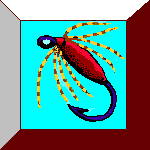



The two genera of the family Leptophlebiidae, Leptophlebia and Paraleptophlebia, are found in trout streams and are of importance to the angler. The nymphs have three tails of equal length which are longer than the body and have hair on both sides. The antennae are longer than the thorax and head combined. Bodies are not strongly flattened and display gills that are very noticeable, being either double platelike or deeply forked. Probably the best method for recognizing the adults is to study wing veination. In the fore wing, Cu2 is sharply bent and there are no long intercalary veins between M2 and Cu1. Three tails are maintained and the size range is 6 to 12 mm.
The genus Leptophlebia contains two important species, Leptophlebia cupida, which is common to the East and Midwest, and Leptophlebia johnsoni, which is found in the west. The nymphs have double, platelike gills with long filamentous extensions on abdominal segments 2 to 7 and gills that are deeply forked on the first segment. One peculiar characteristic of the nymphs is their habit of upstream migration prior to hatching. Large numbers have been known to travel as far as a mile, moving along the bank in quiet water. In the adult stage, the middle tail is shorter than the outer ones, wing veination is very distinctive, and bodies are robust.